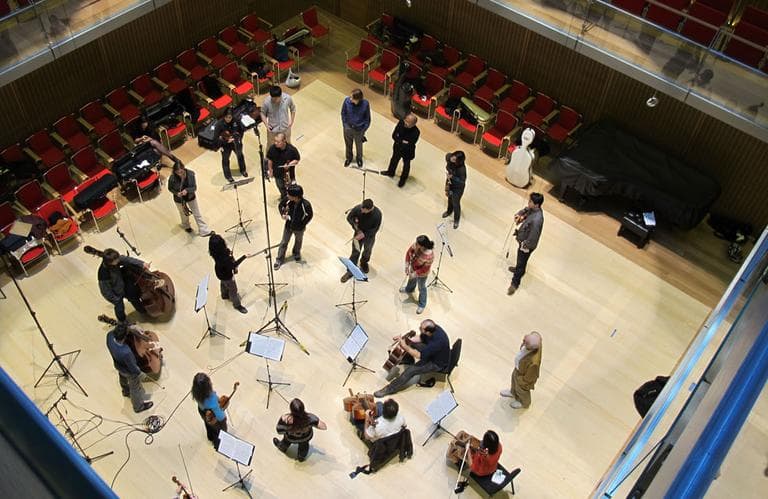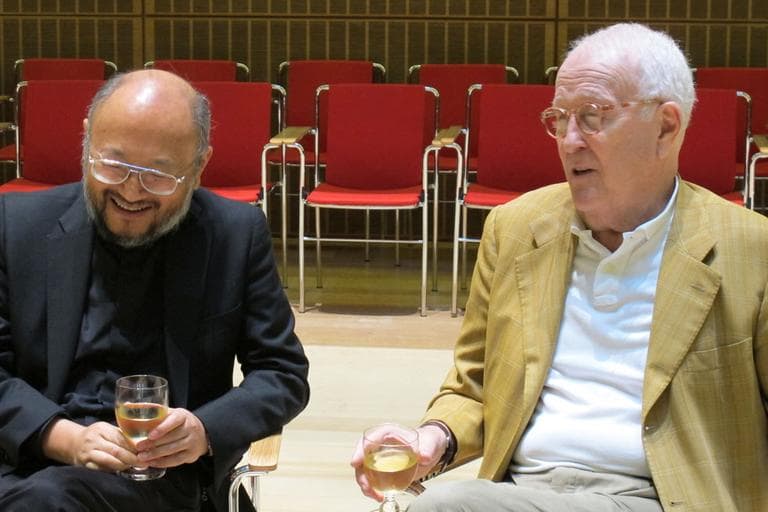Advertisement
Gardner Museum’s Concert Hall Finds Its Voice
Resume
The Isabella Stewart Gardner Museum is kicking into high gear now that the January opening of its new $180 million expansion is on the horizon. A state-of-the art performance hall is a big part of the upgrade.
This week — after five years of planning — the museum's cube-shaped concert space is undergoing some pretty serious acoustical testing. On Wednesday morning I dropped in to see how it's sounding.
When I arrived I expected seasoned acoustician Yasu Toyota to be plugged into all sorts of high-end, high-tech testing devices. But when he first assesses the sound of any space he actually goes no-tech, relying on some the most basic of human instruments: his hands.
“Like this,” Toyota said as he illustrated the age-old art of clapping. “So this is a kind of tool,” he explained, saying he also snaps and sometimes even pops a blown up paper bag. “And so if we could have some actual music we don't need this.”
Enter members of A Far Cry, the Gardner Museum’s resident chamber orchestra. A posse of more than a dozen string players was enlisted to help test the hall’s brightness, clarity and warmth. The players stand on pale, wooden floorboards bowing short pieces of music. They were selected specifically for this task.
As Toyota sees it, “Actual hearing is more important, rather than analyzing data which is gathered from a microphone.” He drew the comparison to what a medical doctors does -– relying on X-rays and ultrasounds, but then looking at the physical human body for a true diagnosis.
It's all about the ears, said Toyota, who works for Nagata Acoustics, a Japanese firm with an office in Los Angeles. He’s been in the business for decades, but admits he was a little nervous when he arrived for this milestone moment in Boston.
“If Yasu was nervous, just triple that, and it’s how nervous I was,” said the museum's music director, Scott Nickrenz. For the past five years, Nickrenz has been living and breathing plans for this unique, 6,000 square-foot concert hall.

Nickrenz has worked closely with Toyota and architect Renzo Piano to design the jewel-box performance space. Beautiful form and sublime function were absolute requirements, Nickrenz said, and now, “The concert hall found its voice.”
The sound and the view from the fourth floor balcony are crystal clear. Looking down, the bird's-eye perspective is unlike any other music hall I’ve experienced. A novel design and performance feature is one that seems to have come to Nickrenz in a dream.
“I woke up in the middle of the night, it was about 3 o'clock in the morning and suddenly realized that this space should not have a stage,” he said.
Nickrenz proceeded to call his boss, museum director Anne Hawley — at 5:30 a.m. — to share his epiphany.
“She was pretty irritated,” he said, but Hawley was also open-minded to his kind of crazy idea because she's a music-lover too.
Then Nickrenz proposed it to Toyota.
“Crazy is very, very important,” the acoustician said with a laugh (but in all seriousness).
And so the hall is shaped like a big cube made of cement, steel and wood. The ceiling is 42 feet high. Nearly 300 seats fill three tiers of balconies that rise up to line all four walls. Those walls are covered in perforated wood paneling with hidden compartments that can be changed for each performance. Nickrenz refers to them as the “secret” to this room’s sublime but flexible sound.
For decades he’s programmed concerts for the Tapestry Room inside Isabella Stewart’s palazzo. It was challenging on many levels, but especially sound-wise. With this new, acoustically perfect hall, audiences will enjoy music in a very different way, Nickrenz believes. But he's also concerned about the musicians.
"I want them to feel embraced by the new concert space. I want them to feel hugged," he said.
The musicians from A Far Cry clearly felt excited during the testing. One violinist couldn’t contain himself and shouted out, “This is awesome!” He and his peers spent a good amount of time shifting around the room to gauge how the ensemble might sound –- and look -– arranged in different configurations.
“Whichever way we stand it sounds great in here,” violinist Annie Rabbat told me during a break. “We don't have to fight the hall, and so often that's the case, either to get the sound to project — or to ring — or to be clear.”
And Rabbat's assessment is music to Nickrenz’s ears. After his five-year journey with acoustician Toyota he looked at me and said, “It's exactly as Yasu promised.”
This program aired on November 10, 2011.
